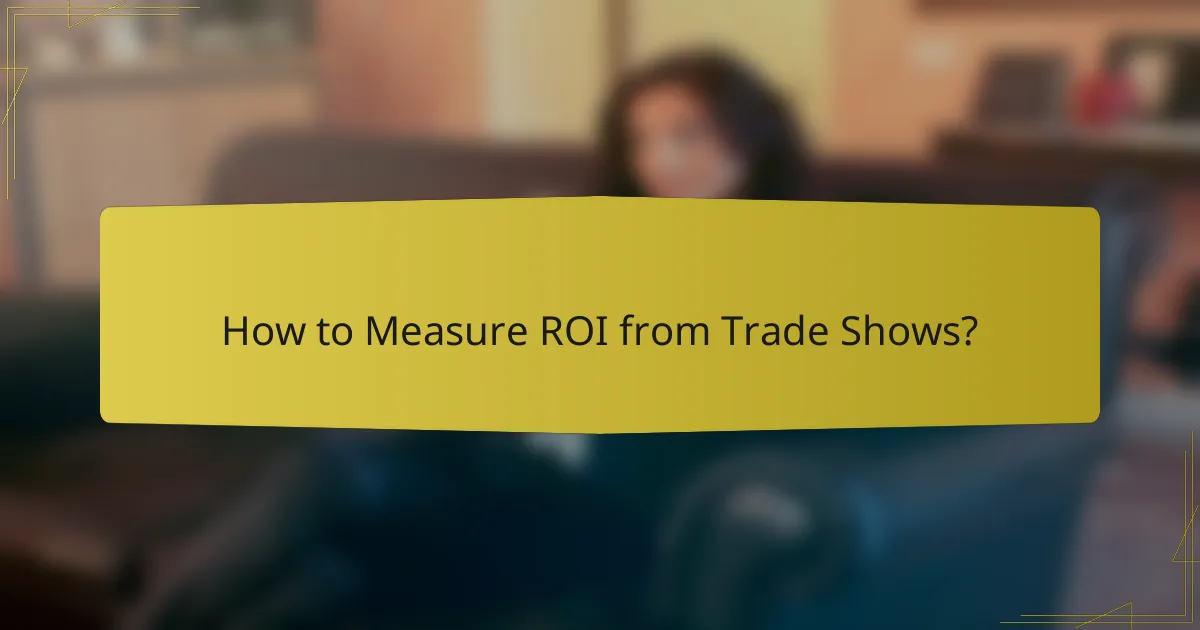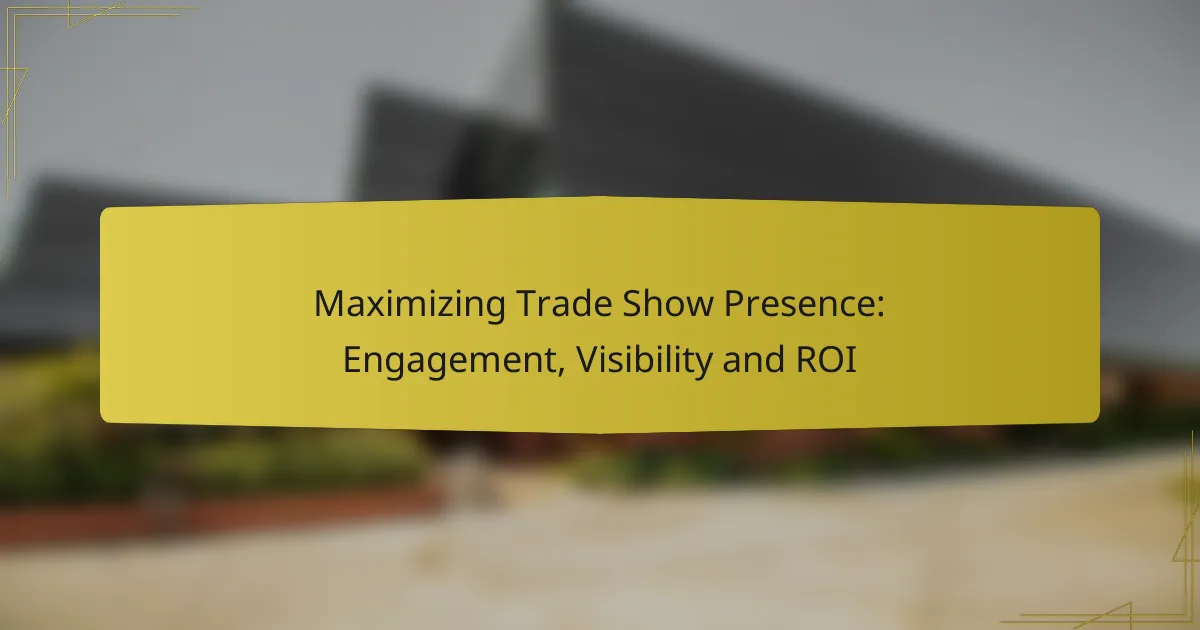Maximizing your trade show presence requires a strategic approach that emphasizes engagement, visibility, and measurable ROI. By creating interactive experiences and focusing on effective branding and marketing, you can attract more attendees and foster meaningful connections. Additionally, evaluating key metrics will help you assess the financial returns of your participation, ensuring that your investment yields significant results.

How to Increase Engagement at Trade Shows?
To increase engagement at trade shows, focus on creating interactive experiences that draw attendees in and encourage participation. Engaging activities help to capture attention, foster connections, and ultimately enhance your return on investment.
Interactive Booth Activities
Interactive booth activities are essential for attracting visitors and keeping them engaged. Consider incorporating hands-on experiences, such as product trials or interactive displays, that allow attendees to actively participate rather than just observe.
Examples include virtual reality experiences, touchscreens with engaging content, or live polls. These activities can significantly increase foot traffic and create memorable interactions that resonate long after the event.
Live Demonstrations
Live demonstrations showcase your products or services in real-time, providing a dynamic way to engage attendees. Schedule regular demos throughout the day to maintain interest and draw in crowds.
Ensure that demonstrations are concise and highlight key features or benefits. Engaging presenters can make a significant difference, so choose individuals who are not only knowledgeable but also charismatic and able to connect with the audience.
Networking Events
Networking events provide opportunities for attendees to connect with your team and each other, fostering relationships that can lead to future business. Host informal gatherings, such as coffee breaks or happy hours, to create a relaxed atmosphere for networking.
Consider partnering with other exhibitors to co-host events, which can expand your reach and attract a larger audience. Providing incentives, like exclusive access or giveaways, can further encourage participation.
Gamification Strategies
Gamification strategies involve incorporating game-like elements into your booth to motivate and engage visitors. This can include contests, quizzes, or scavenger hunts that encourage attendees to interact with your brand.
Offer prizes or incentives for participation, which can boost interest and create a fun atmosphere. Ensure that the games are relevant to your products or services to reinforce your brand message while entertaining attendees.
Social Media Integration
Integrating social media into your trade show presence can amplify your engagement efforts. Encourage attendees to share their experiences online by creating unique hashtags or photo opportunities at your booth.
Consider running social media contests that reward participants for posting about your booth or products. This not only increases visibility but also creates a sense of community among attendees, enhancing their overall experience.

What Strategies Enhance Visibility at Trade Shows?
Enhancing visibility at trade shows involves a combination of strategic design, location, branding, and marketing efforts. By focusing on these areas, exhibitors can attract more attendees and maximize their return on investment.
Eye-Catching Booth Design
An eye-catching booth design is crucial for attracting visitors. Utilize bold colors, unique shapes, and interactive elements to create a memorable experience. Consider incorporating technology, such as touchscreens or virtual reality, to engage attendees more effectively.
Keep the layout open and inviting, allowing easy access for foot traffic. Use high-quality materials and ensure that your booth reflects your brand identity, as this will help establish credibility and professionalism.
Strategic Location Selection
Selecting a strategic location for your booth can significantly impact visibility. Aim for high-traffic areas near entrances, food courts, or major attractions within the venue. Being close to popular exhibitors can also draw more visitors to your space.
Evaluate the floor plan before the event and consider factors like sightlines and accessibility. If possible, invest in a corner booth, which typically offers more exposure than inline spaces.
Effective Signage and Branding
Effective signage is essential for communicating your brand message quickly. Use large, clear fonts and high-contrast colors to ensure readability from a distance. Your signage should highlight key offerings and include a strong call to action.
Consistent branding across all materials, including banners, brochures, and promotional items, reinforces your identity. Make sure your logo and brand colors are prominently displayed to create a cohesive look that resonates with attendees.
Pre-Event Marketing Campaigns
Implementing pre-event marketing campaigns can significantly boost your trade show visibility. Utilize email newsletters, social media, and targeted ads to inform potential attendees about your presence and offerings. Consider offering incentives, such as exclusive promotions or giveaways, to encourage visits to your booth.
Engage with attendees before the event by creating event-specific content or hosting webinars. This not only builds anticipation but also establishes your brand as an authority in your industry, increasing the likelihood of foot traffic to your booth.

How to Measure ROI from Trade Shows?
Measuring ROI from trade shows involves evaluating the financial return relative to the investment made. Key metrics include lead generation, cost per acquisition, and sales conversions, which provide insights into the effectiveness of your participation.
Lead Generation Metrics
Lead generation metrics focus on the number of potential customers acquired during the trade show. Tracking the quantity and quality of leads is essential, as this directly impacts future sales opportunities. Aim for a clear definition of what constitutes a qualified lead to ensure accurate measurement.
Consider using a lead scoring system to prioritize leads based on their likelihood to convert. This can help streamline follow-up efforts and maximize the value of your leads.
Cost Per Acquisition Analysis
Cost per acquisition (CPA) analysis calculates the total cost of acquiring a customer through the trade show. This includes booth costs, travel expenses, promotional materials, and staff time. By dividing total costs by the number of new customers gained, you can assess the efficiency of your investment.
For effective CPA analysis, compare your trade show CPA to other marketing channels. This will help you understand whether trade shows are a cost-effective method for customer acquisition in your overall marketing strategy.
Post-Event Surveys
Post-event surveys are a valuable tool for gathering feedback from attendees and leads. These surveys can provide insights into attendees’ perceptions of your brand, products, and overall experience at the trade show. Use a mix of quantitative and qualitative questions to get a comprehensive view.
Consider incentivizing survey participation with discounts or giveaways to increase response rates. This feedback can inform future trade show strategies and improve engagement efforts.
Sales Conversion Tracking
Sales conversion tracking measures how many leads generated at the trade show ultimately result in sales. This metric is crucial for understanding the effectiveness of your follow-up strategies and the overall impact of the trade show on your sales pipeline.
Implement a system to track leads through the sales process, noting key touchpoints and conversion rates. This will help identify successful tactics and areas for improvement, ensuring better ROI in future events.

What Are the Best Practices for Trade Show Follow-Up?
Effective trade show follow-up is crucial for maximizing engagement, visibility, and return on investment (ROI). Best practices include timely communication, personalized outreach, and implementing lead scoring techniques to prioritize potential customers.
Timely Email Outreach
Reaching out to leads within a few days after the trade show can significantly enhance engagement. This timeframe keeps your brand fresh in their minds and increases the likelihood of a response.
Consider sending a follow-up email within 48 to 72 hours. This can include a thank you note, a recap of your conversation, or additional information about your products or services. Use a clear subject line to capture attention.
Personalized Communication
Personalization in follow-up communications can greatly improve response rates. Tailor your messages based on the specific interests or needs expressed by the lead during the trade show.
For example, if a lead showed interest in a particular product, reference that product in your email and provide relevant resources or case studies. Using the recipient’s name and mentioning specific details from your conversation can make your outreach feel more genuine.
Lead Scoring Techniques
Implementing lead scoring techniques helps prioritize follow-up efforts based on the potential value of each lead. Assign scores based on criteria such as engagement level, company size, and fit with your target market.
For instance, a lead who actively engaged with your booth and requested a demo might receive a higher score than one who simply took a brochure. This allows your sales team to focus on the most promising leads first, optimizing their time and resources.

What Criteria Should You Consider When Choosing a Trade Show?
When selecting a trade show, consider factors such as target audience, location, industry relevance, and cost. These criteria will help ensure that your investment translates into meaningful engagement and visibility.
Target Audience
Identifying your target audience is crucial for maximizing trade show presence. Research the demographics and interests of attendees to ensure they align with your business goals. For example, if you are in the tech industry, look for shows that attract IT professionals and decision-makers.
Consider the size of the expected audience as well. Larger shows may offer more visibility, but niche events can provide deeper engagement with a more focused group. Balance the potential reach with the relevance to your offerings.
Location
The location of a trade show can significantly impact attendance and engagement. Choose venues that are easily accessible for your target audience, whether that means proximity to major transportation hubs or being in a city known for your industry.
Additionally, consider local market dynamics. For instance, a trade show in a region with a strong demand for your products or services can enhance your visibility and ROI. Evaluate the costs associated with travel and accommodations as well.
Industry Relevance
Ensure the trade show is relevant to your industry to attract the right attendees. Look for events that feature exhibitors and speakers from your sector, as this indicates a focused audience interested in your offerings.
Check past attendee lists and exhibitor profiles to gauge the event’s relevance. Participating in industry-specific shows can enhance your credibility and position your brand as a leader in the field.
Cost
Evaluate the overall cost of participating in a trade show, including booth fees, travel expenses, and promotional materials. Weigh these costs against the potential benefits, such as lead generation and brand exposure.
Consider budget-friendly options like shared booths or sponsorships that can reduce costs while still providing visibility. Establish clear ROI metrics to assess the effectiveness of your investment after the event.
